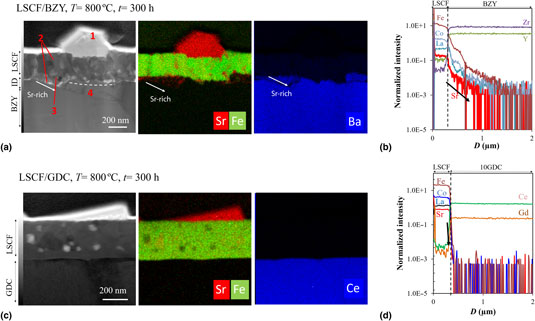Crossref Citations
This article has been cited by the following publications. This list is generated based on data provided by
Crossref.
Chiara, Alessandro
Giannici, Francesco
Pipitone, Candida
Longo, Alessandro
Aliotta, Chiara
Gambino, Marianna
and
Martorana, Antonino
2020.
Solid–Solid Interfaces in Protonic Ceramic Devices: A Critical Review.
ACS Applied Materials & Interfaces,
Vol. 12,
Issue. 50,
p.
55537.
Wang, F.
Yan, K.
Budiman, R. A.
Kishimoto, H.
Ishiyama, T.
Bagarinao, K. D.
Yamaji, K.
Horita, T.
and
Yokokawa, H.
2020.
Effect of Operating Temperature on Sulfur Distribution and Performance Degradation of Porous La0.6Sr0.4Co0.2Fe0.8O3−δ Electrode.
Journal of The Electrochemical Society,
Vol. 167,
Issue. 11,
p.
114507.
Wang, Fangfang
Kishimoto, Haruo
Ishiyama, Tomohiro
Develos-Bagarinao, Katherine
Yamaji, Katsuhiko
Horita, Teruhisa
and
Yokokawa, Harumi
2020.
A review of sulfur poisoning of solid oxide fuel cell cathode materials for solid oxide fuel cells.
Journal of Power Sources,
Vol. 478,
Issue. ,
p.
228763.
Sabarou, Hooman
Wang, Rui
and
Zhong, Yu
2020.
The origin of the phase separation in (La0.8Sr0.2)0.95(CrxFe1-x)O3±δ perovskites for oxygen transport membranes applications.
Solid State Ionics,
Vol. 349,
Issue. ,
p.
115293.
Horita, Teruhisa
2021.
Chromium poisoning for prolonged lifetime of electrodes in solid oxide fuel cells - Review.
Ceramics International,
Vol. 47,
Issue. 6,
p.
7293.
Riedl, Christoph
Siebenhofer, Matthäus
Nenning, Andreas
Schmid, Alexander
Weiss, Maximilian
Rameshan, Christoph
Limbeck, Andreas
Kubicek, Markus
Opitz, Alexander Karl
and
Fleig, Juergen
2022.
In situ techniques reveal the true capabilities of SOFC cathode materials and their sudden degradation due to omnipresent sulfur trace impurities.
Journal of Materials Chemistry A,
Vol. 10,
Issue. 28,
p.
14838.
Develos-Bagarinao, Katherine
Celikbilek, Ozden
Budiman, Riyan A.
Kerherve, Gwilherm
Fearn, Sarah
Skinner, Stephen J.
and
Kishimoto, Haruo
2022.
On the role of surfaces and interfaces in electrochemical performance and long-term stability of nanostructured LSC thin film electrodes.
Journal of Materials Chemistry A,
Vol. 10,
Issue. 5,
p.
2445.
Safian, Suhaida Dila
Abd Malek, Nurul Izzati
Jamil, Zadariana
Lee, Sheng‐Wei
Tseng, Chung‐Jen
and
Osman, Nafisah
2022.
Study on the surface segregation of mixed ionic‐electronic conductor lanthanum‐based perovskite oxide
La
1−x
Sr
x
Co
1−y
Fe
y
O
3−
δ
materials
.
International Journal of Energy Research,
Vol. 46,
Issue. 6,
p.
7101.
Su, Hanrui
and
Hu, Yun Hang
2022.
Degradation issues and stabilization strategies of protonic ceramic electrolysis cells for steam electrolysis.
Energy Science & Engineering,
Vol. 10,
Issue. 5,
p.
1706.
Li, Zhiheng
Li, Mengran
and
Zhu, Zhonghua
2022.
Perovskite Cathode Materials for Low-Temperature Solid Oxide Fuel Cells: Fundamentals to Optimization.
Electrochemical Energy Reviews,
Vol. 5,
Issue. 2,
p.
263.
Zhang, Weizhe
Liu, Menghua
Gu, Xin
Shi, Yixiang
Deng, Zhanfeng
and
Cai, Ningsheng
2023.
Water Electrolysis toward Elevated Temperature: Advances, Challenges and Frontiers.
Chemical Reviews,
Vol. 123,
Issue. 11,
p.
7119.
Krammer, Martin
Schmid, Alexander
Nenning, Andreas
Bumberger, Andreas Ewald
Siebenhofer, Matthäus
Herzig, Christopher
Limbeck, Andreas
Rameshan, Christoph
Kubicek, Markus
and
Fleig, Juergen
2023.
Closed-Pore Formation in Oxygen Electrodes for Solid Oxide Electrolysis Cells Investigated by Impedance Spectroscopy.
ACS Applied Materials & Interfaces,
Vol. 15,
Issue. 6,
p.
8076.
